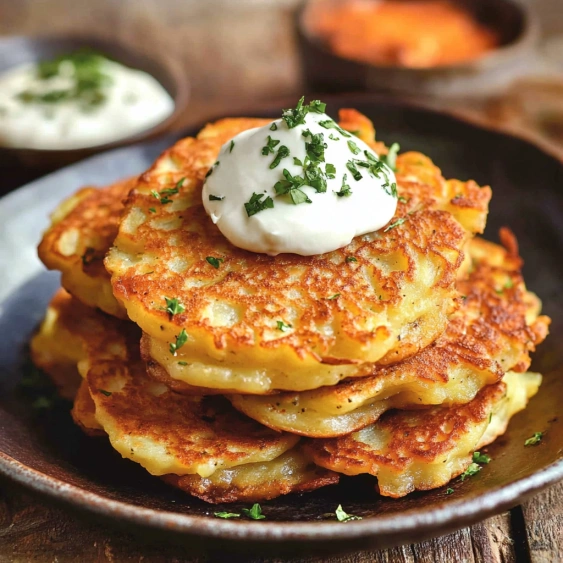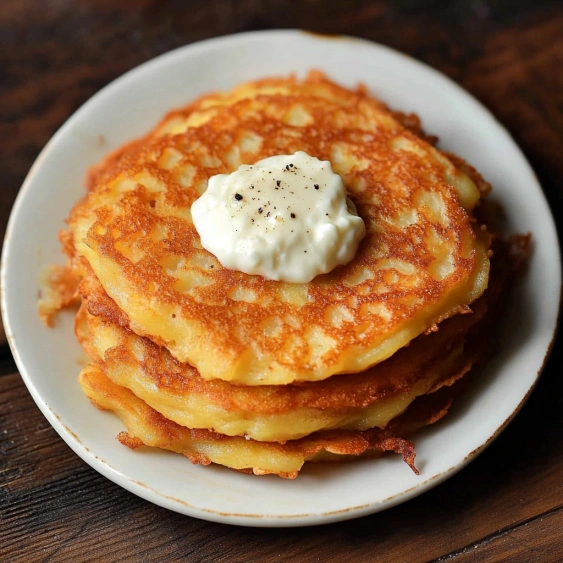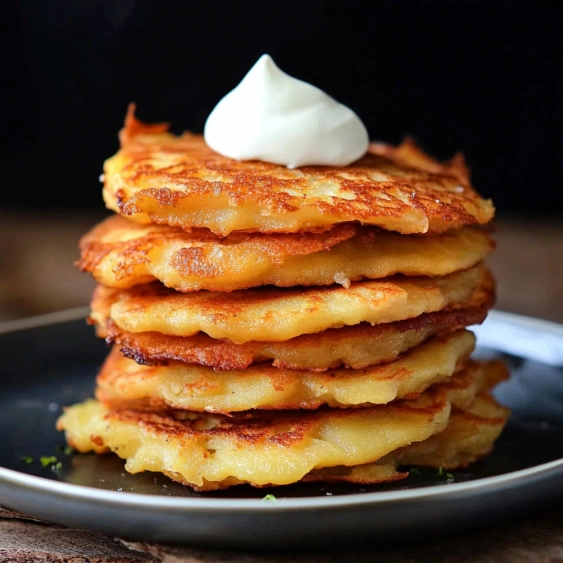 Pin it
Pin it
This classic potato pancake recipe transforms humble ingredients into a crispy, golden comfort food that brings pure joy with every bite. The combination of grated potatoes, onion, and simple seasonings creates the perfect balance of textures and flavors that will have everyone asking for seconds.
These potato pancakes have been my go to recipe whenever I need to create something special with basic ingredients. The first time I made them for my family, they disappeared within minutes, and now they are requested at almost every holiday gathering.
Ingredients
- 3 lbs Idaho or Russet potatoes: ideal for their high starch content which helps create the perfect texture
- 1 medium onion: adds subtle sweetness and depth of flavor
- 2 eggs: act as the essential binder that holds everything together
- 2-3 tbsp all purpose flour: helps absorb moisture and creates structure
- 1 tsp garlic powder: provides aromatic depth without overpowering
- 1 tbsp fresh minced dill weed: brings brightness and traditional flavor
- Salt: enhances all other flavors in the pancake
- Fresh cracked black pepper: adds subtle warmth and complexity
Step by Step Instructions
- Choosing Your Texture:
- Decide whether you prefer shredded potatoes for more texture or finely grated potatoes for a smoother pancake. A box grater creates either texture manually, while a food processor with grating attachment speeds up the process for shredded texture, or use the regular blade for a finer consistency.
- Preparing The Base:
- Peel both potatoes and onions completely. Grate or process them according to your texture preference until no chunks remain. The consistency should be uniform throughout for even cooking.
- Removing Excess Moisture:
- Transfer the potato onion mixture to a fine strainer set over a mixing bowl. For finely processed potatoes, place the mixture in a mesh vegetable bag or doubled cheesecloth first, then into the strainer. Press firmly to extract as much liquid as possible. This crucial step prevents soggy pancakes and ensures crispiness.
- Preserving The Starch:
- Carefully pour off the liquid from the collection bowl but keep the white starchy sediment at the bottom. This natural potato starch works as an additional binder and contributes to the perfect texture.
- Creating The Batter:
- Return the squeezed potato onion mixture to the bowl containing the starch. Add eggs, flour, salt, garlic powder, and fresh dill. Mix thoroughly until all ingredients are well incorporated and seasonings are evenly distributed.
 Pin it
Pin it
My grandmother taught me to respect the starch that settles at the bottom of the bowl. She would say that discarding it was like throwing away gold. That lesson stuck with me, and now my potato pancakes always have that perfect balance of crispiness and tenderness that reminds me of her kitchen.
Storage Solutions
Potato pancakes can be stored in an airtight container in the refrigerator for up to three days. For best results when reheating, place them on a baking sheet in a 350°F oven for about 10 minutes until they regain their crispiness. Avoid microwaving as this will make them soggy. If you make a large batch, cool them completely before layering between parchment paper and freezing. Frozen pancakes can be reheated directly from frozen in a 375°F oven for 15-20 minutes.
Serving Suggestions
Traditional potato pancakes shine with simple toppings. Try them with a dollop of sour cream and applesauce for a classic presentation. For a more elegant approach, top with crème fraîche and smoked salmon. They make an excellent base for eggs benedict or can be served alongside roasted meats as a starchy side dish. For a brunch spread, offer various toppings and let guests customize their pancakes.
 Pin it
Pin it
The Cultural Significance
Potato pancakes appear in many cultures under different names. They originated as a way to stretch ingredients during lean times but evolved into beloved traditional dishes. In Eastern European Jewish cuisine, they are known as latkes and traditionally served during Hanukkah. German potato pancakes or kartoffelpuffer are popular at Christmas markets. Polish placki ziemniaczane are often served with goulash. This recipe honors these traditions while being adaptable to modern tastes.
Frequently Asked Questions
- → What's the best type of potatoes for potato pancakes?
Idaho or Russet potatoes work best for potato pancakes because they have a high starch content that helps bind the mixture. Their relatively low moisture content also helps achieve crispier pancakes.
- → Why is it important to drain the potato mixture?
Draining the potato mixture removes excess moisture, which is crucial for achieving crispy pancakes instead of soggy ones. However, it's important to keep the starch that settles at the bottom as it helps bind the pancakes together.
- → Can I make these potato pancakes gluten-free?
Yes! Simply substitute the all-purpose flour with gluten-free all-purpose flour as mentioned in the ingredients list, and ensure all other ingredients are gluten-free.
- → What's the difference between using a box grater versus a food processor?
A box grater allows more control over the texture - you can create either shredded or fine texture. A food processor with a grating attachment quickly produces shredded potatoes, while pulsing potatoes in a food processor creates a finer texture. The texture choice affects the final consistency of your pancakes.
- → What can I serve with potato pancakes?
Potato pancakes pair wonderfully with applesauce, sour cream, or yogurt. They're also delicious with smoked salmon, caviar for special occasions, or simply with a side of crisp green salad for a complete meal.
- → Can potato pancakes be made ahead of time?
While best served immediately after cooking for maximum crispness, you can make them ahead and reheat in a 350°F oven for 5-10 minutes. For longer storage, freeze cooked pancakes between layers of parchment paper and reheat from frozen.
